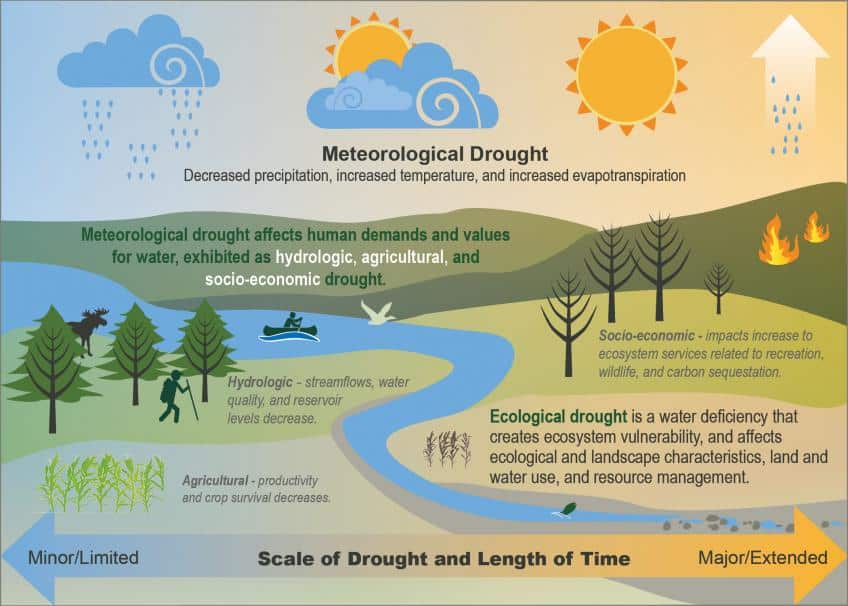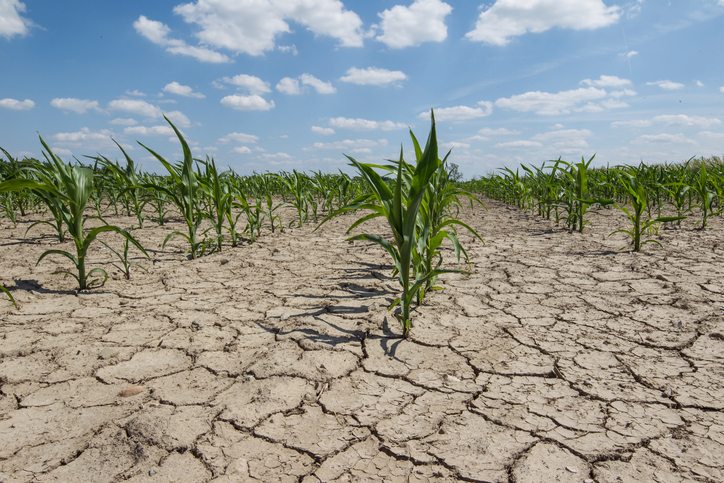In this article, You will read about Drought: Types, Causes & Consequences of Drought for UPSC Notes.
Drought
- Drought is a temporary reduction in water or moisture availability below the normal or expected amount for a specific period.
- The occurrence of substantially lower than average precipitation in a season that normally has ample precipitation in a season for the support of cereal and non-cereal crops is known as Drought.
- The amount, time, and distribution of rainfall matters. In India, the erratic nature of the summer monsoon with long dry spells and high temperature are responsible for the drought conditions. On average, one in every 5 years is a drought year. In Rajasthan, one in every 3 years is a drought year.
- Drought is a relative phenomenon as the inadequacy is with reference to prevailing agro-climatic conditions. Aridity is a permanent condition whereas drought is a temporary situation. Arid and semi-arid regions are more prone to drought.
Types & Causes of Drought
1. Meteorological Drought
- It is a situation where there is a reduction in rainfall for a specific period below a specific amount i.e. the actual rainfall in an area is significantly less than the climatologically mean of that area. According to Indian Meteorological Department (IMD), a drought exists when the average annual rainfall is less than 75% of the normal.
- IMD also mentioned that rather than the total amount of rainfall, its evenness matters more. We can observe that even though India gets an average annual rainfall of 110 cm, the evenness of rainfall, due to the erratic and concentrated nature of rainfall, there are frequent droughts.
- Causes of Meteorological droughts:
- Lean monsoon and below-average rainfall.
- Late-onset or early withdrawal of monsoons.
- Prolonged breaks in Monsoon.

2. Hydrological Drought
- It is associated with the reduction of water levels. There are 2 types of Hydrological Droughts
- Surface water Drought – It is concerned with the drying up of surface water resources such as rivers, streams, lakes, ponds, tanks, reservoirs, etc.
- Groundwater Drought – It is associated with the fall in the groundwater level.
- Causes of Hydrological Drought:
- Large scale deforestation.
- Ecologically hazardous mining.
- Excessive pumping of groundwater.
3. Agricultural Drought
- It occurs when soil moisture goes below the level needed to sustain plant growth. It is also called as Soil Moisture Drought. The erratic rainfall conditions and inadequate soil moisture result in crop failures.
- Causes of Agricultural Droughts:
- Excessive use of High Yielding Seeds (HYV) as these seeds requires more water and proper irrigation.
- Change in cropping pattern. E.g. with the introduction of the green revolution, we increased our production of wheat and rice. Rice is a water-intensive crop and growing them in an area where less water is available made the area prone to agricultural drought.

4. Socio-Economic Drought
- It reflects reduced availability of food and income loss due to crop failure.
5. Ecological Drought
- It occurs when the productivity of the natural ecosystem fails due to a shortage of water and causes environmental damages like the deaths of cattle, wildlife, and trees in the forest.
Droughts in India
Droughts in India have their own peculiarities requiring an appreciation of some basic facts.
These are:-
- India has an average annual rainfall of around 1150 mm. No other country has such a high annual average; however, there is considerable annual variation.
- More than 80% of rainfall is received in less than 100 days during the south-west monsoon and the geographic spread is uneven.
- 21% area receives less than 700 mm rains annually making such areas the hot spot of drought. Inadequacy of rains coupled with adverse land-man ratio compels the farmers to practice rain-fed agriculture in large parts of the country (approx 45%).
- Per capita, water availability in the country is steadily declining. Irrigation, using groundwater aggravates the situation in the long run as groundwater withdrawal exceeds replenishment. In the peninsular region availability of surface water itself becomes scarce in years of rainfall insufficiency.
Most Drought Prone areas in India
- Northwest Region being the arid and semi-arid region of India receives the residual rain from the monsoon as monsoon time over this region is nearly 2 months. Rajasthan and some parts of the west-central areas come in this category.
- Other naturally drought-prone areas are the kutch and the Thar desert region which cannot be fully rectified, what can be done is to reduce the impact by using irrigation methods and crops suitable for the region.
- Peninsular region- The leeward side (rainshadow region) of the western ghat receives little rainfall. Also, this area lacks irrigation. Adding to the deficit rainfall the crops which are chosen on a commercial basis are not suitable for that agro region like cotton and sugarcane in Marathwada which demand high water availability.
- About 30% of the country’s total area is drought-prone affecting 68% of the total sown area. Severity wise, the years of 1965, 1972, 1979, 1987, 2002, 2009, and 2012 were the most severe drought years in post-independence India.
Consequences of Droughts
The direct impact of the drought is generally classified under three categories, viz, Social, economic, and environmental. The relative and absolute magnitudes of each impact will however depend on specific regional characteristics.
- Economic losses:
- It includes a decline in cultivated areas and a fall in agricultural production, which leads to the slowing down of secondary and tertiary activities and a decline in purchasing power.
- Environmental Impact:
- It leads to damages to plant and animal species, wildlife habitat, air and water quality, forest and range fires, degradation of landscape quality, and soil erosion.
- Soil moisture, surface run-off, and groundwater table get adversely affected.
- Impact on society:
- Migration of people from drought-hit areas to other areas in search of livelihood and food.
- Farmers tend to commit suicide. Maharashtra, Andhra Pradesh, and Karnataka are the states having maximum farmer suicides.
- Disruption of social institutions and increase in social crimes.
- Scarcity of drinking water, food grains and hence causes famine and starvation.
- Poor health and spread of diseases like diarrhoea, cholera, and other diseases associated with malnutrition, a hunger which sometimes causes death.
Drought Management
Drought management encompasses three-fold structures and each step needs a holistic approach to ensure effective end result. The 3 components are-
- Drought intensity assessment and monitoring
- Drought declaration and prioritization of affected areas for management
- Development and implementation of drought management strategies.
NDMA guidelines for Drought Management-
- NDMA guidelines include developing vulnerability profiles for regions, communities, population groups, and others to compile critical information which when integrated into the planning process can enhance the outcome of the process of identifying and prioritizing specific areas.
- Specific Drought Management cells should be created at the state level under SDMA. These DMCs will be responsible for the preparation of vulnerability maps for their respective states. Arid and semi-arid areas that are most vulnerable should be given priority where drought is a recurring feature occurring with varying magnitudes.
- Specific guidelines for use of Information and Communication Technology (ICT) and role of the National Informatics Center (NIC) for online interaction and availability of real-time drought-related information that will help in the assessment and early warning.
- Assessment of damage expected will include agricultural production, depletion of water resources, livestock population, land degradation, and deforestation as well as human health.

Your all Articles are Fabulous…….
I am unable to see the diagrams please help
Clear your cache by clearing browsing history.
Great work sir just the content what exactly the students need
Can you reconsider India’s avarage annual rainfall as 1150mm